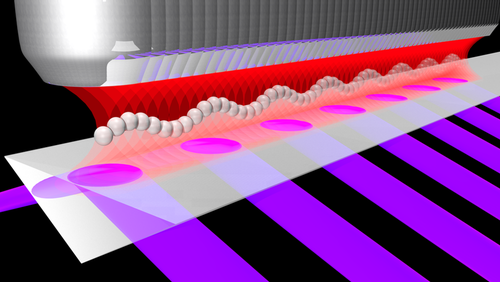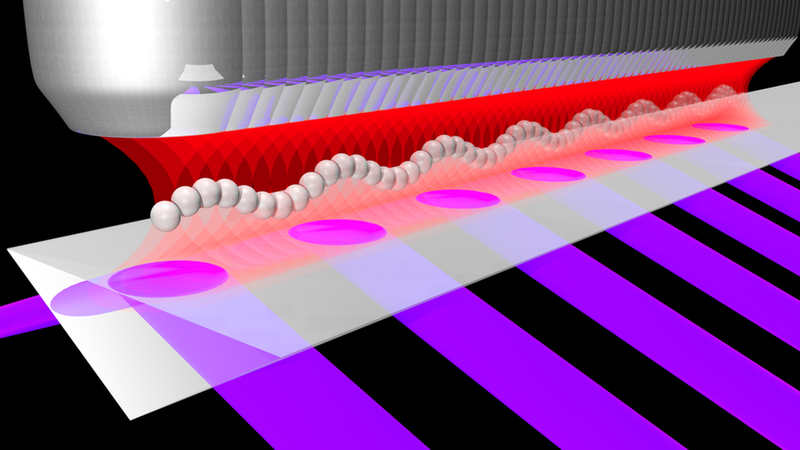Detecting Femtonewton Forces in Water
Forces between biological molecules or colloidal particles can be as small as femtonewtons (fN—about the weight of the smallest bacterium). Measuring such forces is challenging in water for several reasons, including the random jiggling of water molecules, but now a team has refined a standard force-measurement method to the point where it can attain this sensitivity. The technique involves the so-called lock-in principle, where a small signal is extracted from the background noise by making it vary with a precise frequency. In this case, the force exerted on a microscopic plastic bead oscillates. The researchers hope the system can be used for measuring some of the exotic, weak forces predicted to act on particles interacting with light.
Forces far smaller than a femtonewton can be detected in high-vacuum conditions, where objects aren’t being buffeted by random collisions [1]. In solution, the sensitivity is lower, although methods have been reported for detecting forces as small as 20 fN [2]. Having a method to detect weaker forces in water could, for example, help researchers explore the mechanics of living cells. Lulu Liu and colleagues at Harvard University have now attained a limit about a hundred times smaller than the previous record, measuring sub-femtonewton forces on a microscopic polystyrene bead suspended in water close to a coated glass surface.
They use a technique called optical tweezers, in which a small object is trapped at the central focus of an intense laser beam. To measure the displacement of the object from the focus due to an outside force, researchers observe changes in the light-scattering of a second, "probe" beam. The force can then be calculated from this change in position.
The researchers used this technique to measure the force on a series of optically trapped polystyrene spheres 0.5–2 micrometers in diameter. For a small but controllable force, they used a so-called evanescent light field—the electromagnetic field that emerges just outside a glass surface due to the reflection of light within the glass.
Measuring this tiny force's effect on the bead is difficult because it is constantly buffeted by water molecules. The measurement is also compromised by so-called 1/f noise in the apparatus. This noise is common in many experiments and is not fully understood. But because the 1/f fluctuations are larger at low frequencies, their influence can be reduced by varying the force with a relatively high frequency. So the team varied the intensity of the laser beam responsible for the evanescent field using a beam chopper, a device that periodically blocks the beam. This "lock-in" approach is common in many areas of experimental physics where one needs to extract a weak signal from a noisy background.
The remaining disturbance due to thermal noise can be overcome by taking a force measurement over a long enough time for the noise to be averaged away. The smaller the force being measured, the longer this measurement time needs to be. To reach a sensitivity of less than a femtonewton, the measurement must be carried out for around 100 seconds. This relatively long time is still better than the 10–15 minutes that previous methods required to detect tens of femtonewtons, according to Liu. The researchers found that the decrease in force as a bead is held at increasing distances from the surface closely matches the predictions of Mie scattering theory, which describes photon scattering by objects as small as the light's wavelength.
“The sensitivity achieved in this work is indeed impressive for detection in a liquid environment,” says Andrew Geraci of the University of Nevada at Reno, a specialist in precision force measurements. He stresses that, for the method to work, it needs to be possible to vary the applied force in some way; it won’t work for static forces. But such variation should be feasible for various kinds of fundamental light-matter interactions, as well as in some biological situations—using optogenetics, for example, where light-sensitive proteins are inserted into cells to control their functions.
What’s more, 100 seconds may be too long to measure some tiny biological forces, if they act for only a very short time, says Geraci. “For studies where force actuation happens quickly, this technique will not be as applicable, since averaging for seconds may not be possible.” Liu plans to improve the technique and says she would also like to measure certain weak forces of light that should depend on the photon spin, among other exotic effects.
This research is published in Physical Review Letters .
–Philip Ball
Philip Ball is a freelance science writer in London. His latest book is How Life Works (Picador, 2024).
References
- G. Ranjit, M. Cunningham, K. Casey, and A. A. Geraci, “Zeptonewton Force Sensing with Nanospheres in an Optical Lattice,” Phys. Rev. A 93, 053801 (2016).
- L. Helden, R. Eichhorn, and C. Bechinger, “Direct Measurement of Thermophoretic Forces,” Soft Matter 11, 2379 (2015).





